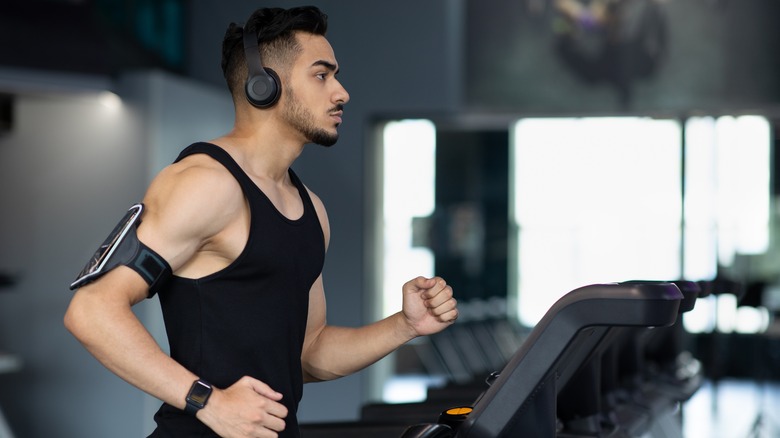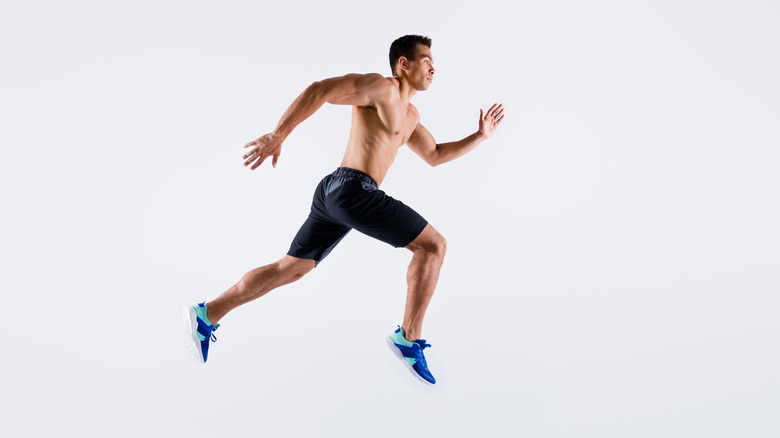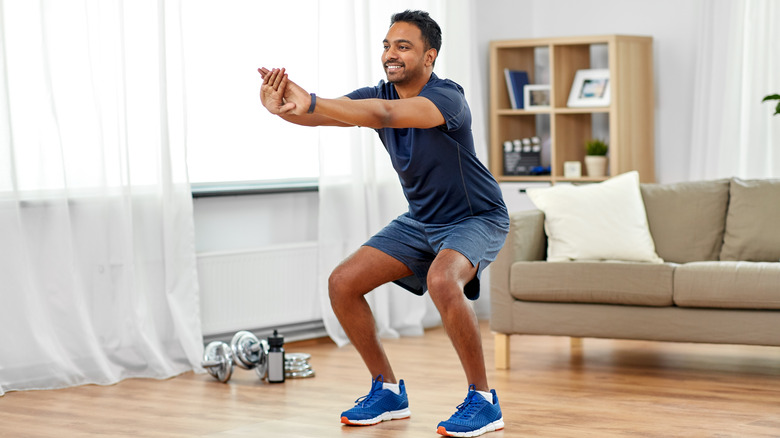Tips For Improving Your Running Form
For as long as humans have been around, they've run. And these days, running is a near-enough obsession for millions of people worldwide. In 2021, the size of the running market worldwide reached a whopping (wait for it) $36.8 billion, according to IMARC — and consumers could be forgiven for thinking that the more money they spend on the perfect gear, the better their run will be.
But the thing is, you can spend all the money you want on high-end shoes and breathable fabrics, but if your form isn't up to scratch, that's where your run will suffer. While "there is no right way to run, nor is there a wrong way to run," says Reed Ferber, biomechanist and University of Calgary Running Injury Clinic director (via SELF), how you move your body during your jog may have a significant impact on your performance and comfort.
And while not everyone may have the time to perform an in-depth analysis of their running form (and may not need to), it's worthwhile to keep some key basics in check during your exercise. And we've got you covered, folks. Check out our top tips for your running form right here.
Ensure that you're replacing your shoes regularly
Running really does all start in the feet, and what you're wearing on them is more important than we can say. And if you haven't changed your running shoes in a while, it could be having a big impact on how you're using the rest of your body. "An older running shoe that has tons of miles logged on it won't be as responsive, cushioned or supportive as a new pair," says Greg Laraia, Custom Physical Therapy running consultant (via Livestrong). This can cause adaptations to your running form to compensate and may lead to an increased chance of injuries throughout your legs. These adaptations were observed in a study published in the British Journal of Sports Medicine, in which participants were found to change their running patterns as their shoes wore down.
It's important, therefore, to be aware of when your shoes might be past their prime, and change them once their time's up. Your running shoes will generally need replacing once you've run between 300 to 500 miles, but Laraia recommends checking them visually to see if the tread has worn out.
It's also important to consider how they feel. If your foot feels as though it's striking the ground too hard, it could be time to get a new pair.
Think about your impact
If you're a running aficionado with all the latest gear, you probably already know the following, thanks to the pedometer on your wrist ticking endlessly upward — but here goes anyway: When you're running, you take a lotta steps. And every time your foot hits the ground, it could be an opportunity to make your form a little better. A study published in the American Journal of Sports Medicine examines the effects of a gait retraining program, which was administered to participants over two weeks.
The study's researchers then followed the runners for a year, to examine what effect the retraining program had. It was found that, following the gait retraining program, the impact of their feet as they struck the ground was significantly less, and this then led to a much lower risk of injury overall. This occurred because the runners were trained in such a way that they focused their stride more toward the front of the foot, and reduced the length of each step (per Runner's World). As such, it could be worth considering how you step next time you head out for a jog — but bear in mind that any changes will be gradual, and it might not even be necessary to make any alterations if you're not experiencing regular injuries.
Focus on your breath
Breathing well is fundamental to a good run. And focusing on your breathing technique could have a serious impact on form, ensuring that your breath is working in tandem with your running movements (per Active). Alongside trying to make sure you're breathing deeply into your stomach, timing your breath to operate with your stride could benefit you. This practice, known as "rhythmic breathing," takes away unnecessary impact on your body when running by timing your inhales with foot strike, thereby keeping our bodies stable and our core from being compromised (per the American Lung Association).
Rhythmic breathing operates by breathing in and out on a cycle of five steps, with three steps to inhale, and two more as you exhale. The odd number of steps for each full breath means that you're not repeating the in- and out-breaths on the same foot every time, and instead alternating between them, which creates a better sense of balance throughout your whole body and avoids your diaphragm and core getting stressed out by your breathing pattern.
It all starts in the head
It might be easy to assume that when you're running, your head isn't really involved. After all, all of the action's going on in your feet and legs, so does it matter what you're doing from the neck up? Well, yes, it does. Your head is held in place (running or not) by the bones and muscles that run through your back, and when you're moving your head forward too much, this affects how you hold your upper body, potentially leading to unnecessary muscular stress (per Kinetic Revolution).
Beyond that, your head is constantly receiving and processing information while you run, which keeps you safe and balanced, and your run effective.
The best thing to do is to just keep things natural. Keep your eyes focused forward, to look where you're going, instead of allowing them to look too far down or at your feet (per Runner's World). By doing this, you'll organically bring your head, neck, and back into alignment. Ensure that, while you're doing this, you're not allowing your head to lean too far back, or your chin to come forward too much.
Consider what you're doing with your shoulders
Are you sitting at a desk right now? If so, are your shoulders hunched up around your ears? If not, we salute you — because it can be a common issue to have, and when you're running, you might notice the same thing. Your shoulders come along for the party when you run, but incorrect form during exercise can lead to bunching your shoulders up or rounding them off, according to UPMC Health Beat. Although this might not seem like much of an issue, holding your shoulders unnaturally can, over time, lead to muscle tension, strain, nerve and blood vessel pressure, and even rotator cuff injuries.
To tackle this, you first have to assess your form. Ensure that you're running with a long, loose spine and that your upper body is tilting slightly forward, with your hips and pelvis free of any additional tension. Keep your shoulders dropped throughout your run, and make sure you're checking in with them throughout your exercise, to avoid tension creeping up into them as you clock up the miles. It's also important to keep your muscles both stretched and strong — this will help you avoid any imbalances or compensation from other parts of the body.
Engage your core
Your core is (in a sense) the glue that holds your body together — the same is true when you're running. Your core stabilizes your body as your foot strikes the ground during a run, and keeps both the energy moving through your body and you moving in a forward motion (per Podium Runner).
But when your core isn't in the correct form, your running performance can quickly become compromised — which is why keeping on top of it during exercise is vital. "Your power comes from your torso/core so you want to make sure that it's erect and not slouched, which can make it difficult to breathe," says Alison Désir, certified run coach, via SELF. Ensure that your core is activated throughout your run, and is operating as part of your body as a whole.
The angle that you hold your core at is also crucial, with biomechanist Reed Ferber recommending that you keep your upper body at about a 10-degree angle, hinging forward. "This helps to reduce braking forces and helps to propel you forward," Ferber says. If you're having difficulty with your core throughout your run, or are finding it hard to keep it activated, it may be worthwhile to do some core strengthening, with exercises that target your deeper abdominal muscles specifically.
Your arms play a part
You'll have probably noticed when you're out for a run, that your arms just can't resist getting involved. And although your upper limbs naturally fall into a pattern while you're running, it's still worthwhile to consider how you're holding them. Your arms work alongside your steps to keep your body moving forward, while your hands (and how you hold them) can determine how much tension you're holding up top (per Runner's World). As such, any imbalances or problems with form could compromise your run.
Ideally, your arms should be allowed to move naturally, with your forearms at a 90-degree angle to your upper arms. Try to avoid your arms swinging too horizontally, and instead focus on letting them move forward and back, in time with your steps. As for your hands, do your best to avoid making a fist or holding too much tension. Ideally, your fingers should be folded gently in, making contact with your hands without pushing against them.
It can be helpful to imagine carrying a delicate object in your hands that you can't break, like a potato chip or a thin piece of glass — until this all becomes habit. At the first sign of tension in your arms and hands, just give them a quick shake out.
Running uphill and downhill might require adjustments
So, you've nailed your form on flat surfaces. You're running along, the picture of athletic perfection, with coordination that Olympic sprinters would be envious of, and then all of a sudden ... BAM! Huge hill, right in front of you, and that form doesn't quite hold up as well as you'd hoped.
Thinking about your form when you're moving uphill or downhill can make a significant impact on your running quality, and it's important to remember that it naturally has to adjust from your regular running stance. When you're moving uphill, it's useful to take smaller and quicker steps, while also lifting your knees a little higher (per Active). Instead of trying to pare back from the hill to maintain balance, shift your body weight forward more, so that you're leaning into it.
Don't forget about your arms, either, as activating them more and increasing their motion will help you generate more power to move upward. When running in a downward motion, shift your weight to the ball of your foot, and allow your arms to come down slightly. Balance here is key, so make sure not to lean forward too much.
Remember to relax
Whether you're aiming for a PB, are pressed for time, or have just had a hard day, it's easy to make what should be a stress-busting and enjoyable run into something pretty tense. But all of this tension is doing you no favors on the form front. As stress works its way into your muscles, it locks your body into positions that compromise your running, with tense shoulders leading to immobilized arms, and crunched postures leading to inefficient performance, explains Active. And above all else, you just won't enjoy yourself when your runs are like this.
Instead? Relax. As well as concentrating on your form, it's also vital that you run with looseness in mind, trying to free your body of any additional strains or holds that could be compromising your performance. Try and take deep breaths and if you notice any tension during your run, pause, shake it out, and continue.
It's also worth trying to free yourself from your own expectations, and what you think your run should be. So you didn't get your best time ever this run? Who cares! Don't let that self-flagellation work its way into your posture. Take it for what it is, release the angst, and enjoy your run. Your form will thank you.
Running on a treadmill can change your form
It's easy to assume that running on a treadmill is equivalent to running in the great outdoors, but that's far from the case. The relative smoothness of a treadmill in comparison to open-road or trail running may decrease injury, but it can also cause you to run differently. Additionally, with their screens and their handrails, treadmill running can result in you making adjustments you wouldn't normally do, and compromising your form as well as performance.
So, when you're on the treadmill, it's the perfect time to focus on form. Keep your spine straight, with shoulders and hips aligned, and core activated (per Healthline). The shorter surface area you have when running on a treadmill will result in you naturally making your strides smaller, so make sure you embrace that and don't try to fight against it — you'll just end up bashing your feet against the front of the machine.
Keep your hands away from the handrails, unless balance is a concern, as this will alter your form considerably. And while it can be tempting to keep your eyes trained on the console in front of you — to examine your performance — instead focus your eyes forward, as you would when running outside.
Don't be tempted to run tall
With all the talk of maintaining a good posture and a straight spine when running, a phrase has risen to the top of the pack: "Run tall." On paper, this makes sense, with a solid core and unbunched shoulders being paramount to running success, but following this advice can also lead to some unintended negatives for your running form. If you're holding yourself too upright when running, your weight can be held back too much — and this alters your form to create additional work for your quads, explains Canadian Running. This not only reduces power and performance while you run but can also lead to quad soreness or strain.
To counteract this, you should consciously introduce a "slight forward lean" into your running stance. While this might seem counterproductive, what this does is transfer more power to your glutes. Bringing these large, powerful muscles into play will then make your performance better, and give your quads a break. A gentle forward lean is especially important if you're running up that hill, as you'll need to recruit more power from the glutes to get you up there. We don't think that was mentioned in the Kate Bush song, but maybe it should've been!
Performing drills can help improve your form
For all of the talk about "improving form," it's way easier said than done. After all, you can head out for a jog with the best intentions, but after five minutes, you'll likely be distracted by something else, and before you know it your body's reverted to its old habits. So how can you make it stick?
Well, performing drills may help, and the best part is, they're simple to do. A balance test, performed by standing on the balls of your feet and activating your core to keep you upright for 60 seconds or so, can offer adjustments to your posture that you can then carry into your running (per Runner's World). Elsewhere, drills that build strength could be useful, to keep your leg muscles toned and powerful.
Simple bodyweight squats, performed for 10 reps across three sets, build strength in the quads which then helps your body absorb the impact of each step. For better arm movement do arm swing drills, performed by placing stickers (labels) on each side of your ribs and practicing sprints where your arms touch them each time — this exercise can prevent arms from swinging horizontally and destabilizing your movement. "An equal arm swing will help keep your legs straight" (via Runner's World).
Keep your muscles loose
Sooner or later, your muscles are going to get tight. Whether it's through sitting in a stationary position for too long, putting additional strain on your muscles, or tightness as a result of working out hard, immobile and painful muscles can create problems for your running routine (per ACE Fitness). When your muscles are tighter, your movement in them can be limited, and this can then create a knock-on effect on your form, making your runs harder.
One of the solutions to this is to make sure that your muscles are loose and prepped for exercise, by stretching them thoroughly. By focusing on your lower leg muscles with specific runners' stretches — both before and after a run — you can generate flexibility and loosen your stiff limbs (per Medical News Today).
Loosening your hip muscles is vital to ensure a good leg swing, so make sure your stretching routine includes a kneeling hip flexor stretch. Kneel on the floor, and then place one foot flat on the ground in front of you, so that you're almost in a small low lunge. Place both of your hands on the bent leg in front, and then gently lean forward, feeling the stretch through your hip. Hold for 30 seconds, and then repeat on the other side.
About analyzing form
While it's tempting to go into a deep-dive of analysis about your running form, it's important to remember that it may not be essential for some people. Generally, if you're running without any significant problems or pain, your form may be fine as it is — and even if you do experience pain, it may not be down to your form, but certain muscles that need attention (per SELF).
Importantly, too, changing your form is not something that you do instantly, and trying to alter running style or posture drastically could generate injuries, advises biomechanist Reed Ferber.
But, if you're looking to make your times better when you run, that's when analyzing form can really come in handy. "If you care about performance at all, improving your technique can improve your running times without requiring you to get fitter," says Mike Young, Athletic Lab Sports Performance Training Center director. "You don't have to run more or train harder, you just need to be more efficient at what you're doing and you'll get better."
And bear in mind that you don't have to revamp your whole running style to do so — just a few changes here or there could make a big difference.















